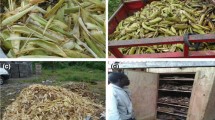Abstract
In this study, carbonisation of four bamboo species viz., Bambusa bambos, Dendrocalamus brandisii, D. stocksii and D. strictus was carried out. The effect of carbonisation temperature i.e., 300, 400, 500, 600, 700 and 800 °C on yield and fuel properties (calorific value, ash, volatile content, fixed carbon content etc.,) of bamboo charcoal was investigated. The soaking time (1 h) and heating rate (5 °C min−1) were kept constant for all experiments. A significant reduction in charcoal yield with increase in the carbonisation temperature was observed in all bamboo species. Fixed carbon content and ash content increased with carbonisation temperature, whereas the volatile content and ultimate hydrogen decreased with increase in carbonisation temperature. Charcoal obtained at 600 °C was found to have highest calorific value. At this temperature, bamboo charcoal yield, fixed carbon content, ash content and calorific value ranged from 30–32, 75–81, 5–10 % and 28–31 MJ kg−1, respectively. The combustion characteristic of bamboo charcoal was studied under oxidizing atmosphere using thermogravimetric analyzer. Bamboo charcoals were found to be different in their combustion behaviour, mainly due to difference in chemical and elemental properties of bamboo biomass and temperature at which the charcoals were made.




Similar content being viewed by others
References
Adkoli NS (2002) Indian bamboos in early 21st century. In: Kumar A, Ramanuja Rao IV, Sastry CB (eds) Bamboo for sustainable development. VSP and INBAR 17–25
Biagini E, Fantei A, Tognotti L (2008) Effect of the heating rate on the devolatilization of biomass residues. Thermochim Acta 1–2:55–63
Demirbas A (2001) Relationships between lignin contents and heating values of biomass. Energy Convers Manag 42:183–188
FSI (2011) India State of Forest Report. Forest Survey of India, Dehradun, p 57
Fujii Y, Azuma J, Marchessault RH, Morin FG, Aibara S, Okamura K (1993) Chemical-composition change of bamboo accompanying its growth. Holzforschung 47(2):109–115
Fuwape JA (1993) Charcoal and fuel value of agroforestry tree crops. Agrofor Syst 22:55–59
Hirata T, Kawamoto S, Nishimoto T (1991) Thermogravimetric of wood treated with water insoluble retardants and a proposal for development of five-retardant wood materials. Fire Mater 15:27–36
Kumar R, Chandrashekar N (2014) Fuel properties and combustion characteristics of some promising bamboo species in India. J For Res 25(2):471–476
Kumar M, Gupta RC, Sharma T (1992) Effect of carbonisation conditions on the yield and chemical composition of Acacia and Eucalyptus wood chars. Biomass Bioenergy 3:411–417
Kumar R, Pandey KK, Chandrashekar N (2008) Effect of carbonization conditions on yield and chemical composition of wood char prepared from selected fast growing fuelwood species. J Ind Acad Wood Sci 5:92–102
Munir S, Daood SS, Nimmo W, Cunliffe AM, Gibbs BM (2009) Thermal analysis and devolatilization kinetics of cotton stalk, sugar cane bagasse and shea meal under nitrogen and air atmospheres. Bioresour Technol 100:1413–1418
Muylaert MS, Sala J, Vasconcelos de Freitas MA (1999) The charcoal production in Brazil- Process efficiency and environmental effect. Renew Energy 16:1037–1040
Nuthayati T (1990) Charcoal manufacturing tests of 4 bamboo species by the pit method. J Penelit Has Hutan 6:495–498
Park SB, Kwon SD, Ahn KM (1998) Development of new uses of bamboos III: studies on general properties of bamboo charcoal. FRI J For Sci 59:25–35
Qiu GX, Shen YK, Li DY, Wang ZW, Hudang QM, Yang DD, Gao AX (1992) Bamboo in sub-tropical eastern China. In: Long SP, Jones MB, Roberts MJ (eds) Primary productivity of grass ecosystems of the tropics and sub-tropics. Chapman & Hall, London, pp 159–188
Saikia P, Kataki R, Choudhury PK, Konwer D (2007) Carbonization of eight bamboo species of northeast India. Energy Sour 29:799–805
Tewari DN (1992) A monograph of bamboo. International Book Distributors, Dehradun 495p
Author information
Authors and Affiliations
Corresponding author
Rights and permissions
About this article
Cite this article
Kumar, R., Chandrashekar, N. Characterization of charcoal from some promising bamboo species. J Indian Acad Wood Sci 11, 144–149 (2014). https://doi.org/10.1007/s13196-014-0128-9
Received:
Accepted:
Published:
Issue Date:
DOI: https://doi.org/10.1007/s13196-014-0128-9




